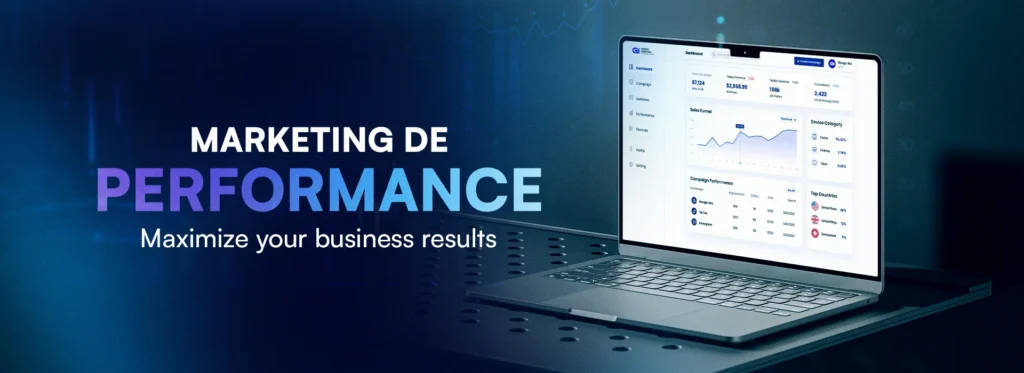In an increasingly digital world, understanding and implementing effective marketing strategies is crucial for any business’s success. Performance Marketing emerges as a powerful approach, focused on measurable results and return on investment (ROI). This article explores in detail the concept of Performance Marketing, its main advantages, and how it can be applied to maximize business success.
What is Performance Marketing?
Definition and Characteristics
Performance Marketing is a digital marketing strategy where advertisers only pay for the results achieved, such as clicks, conversions, or sales. Unlike traditional methods, where you pay upfront for advertising space without guaranteed results, performance marketing ensures that spending is directly linked to measurable outcomes.
Key Elements of Performance Marketing:
- Measurability: All campaigns and actions are monitored, allowing for precise performance analysis.
- Results-Based: Payment is made based on specific actions carried out by the target audience.
- Continuous Optimization: Through detailed analyses, campaigns are continuously adjusted to improve results.
Advantages of Performance Marketing
- Cost Efficiency
One of the greatest advantages of Performance Marketing is cost efficiency. Companies only pay for effective results, meaning every euro spent has a measurable impact on business growth. This approach minimizes waste and maximizes return on investment.
- Transparency
With detailed reports and real-time data, companies can see exactly where and how their budget is being spent. This transparency allows for quick adjustments and informed decisions, ensuring campaigns are always aligned with strategic goals.
- Flexibility and Adaptation
Performance Marketing allows for unprecedented flexibility. Campaigns can be quickly adjusted based on collected data, allowing companies to swiftly adapt to changes in consumer behavior or market conditions.
- Focus on ROI
With a constant focus on return on investment, Performance Marketing helps companies remain results-oriented, ensuring that every implemented strategy directly contributes to business growth.
Main Models of Performance Marketing
- Cost Per Click (CPC)
In the Cost Per Click model, advertisers pay for each click that directs users to their site. This model is effective for increasing web traffic and attracting potential clients.
- Cost Per Acquisition (CPA)
Cost Per Acquisition is a model where payment is made when a specific action is completed, such as a sale or registration. This model is ideal for ensuring that spending is directly proportional to the results achieved.
- Cost Per Thousand Impressions (CPM)
In Cost Per Thousand Impressions, advertisers pay for every thousand views of their ad. This model is often used for brand awareness campaigns, where the main goal is to increase brand visibility.
- Cost Per Lead (CPL)
The Cost Per Lead model involves payment for each qualified lead generated. It is common in lead generation campaigns where the goal is to build a database of interested potential clients.
Implementing a Performance Marketing Strategy
Step 1: Define Clear Objectives
Implementing a Performance Marketing strategy begins with defining clear and measurable objectives. These goals should be specific, such as increasing sales by 20% in a quarter or generating 500 qualified leads in a month.
Step 2: Choose the Right Channels
Choosing the right channels is crucial for the success of any performance marketing campaign. Platforms like Google Ads, Facebook Ads, and Instagram are popular due to their large user base and advanced targeting capabilities.
Step 3: Monitoring and Analysis
Monitoring performance is essential to optimizing performance campaigns. Using analytics tools to track KPIs such as cost per click, conversion rate, and cost per acquisition is fundamental to evaluating campaign success.
Step 4: Continuous Optimization
With data in hand, campaigns should be continuously adjusted to improve results. This includes A/B testing of ads, audience targeting adjustment, and improving landing pages to maximize conversion rates.
Examples of Success in Performance Marketing
Amazon
Amazon effectively uses Performance Marketing by optimizing advertising campaigns through detailed analysis and precise targeting. This approach allows Amazon to maximize ROI and maintain its dominance in global e-commerce.
HubSpot
HubSpot is an example of how Performance Marketing can be used for effective customer acquisition. With campaigns focused on qualified leads and maximizing conversions, HubSpot continues to expand its global customer base.
Integration with Other Strategies
When implementing Performance Marketing, it’s also important to consider how it can be complemented by other approaches, such as Growth Marketing and Growth Hacking. These methodologies can help further maximize the impact of your campaigns by offering valuable insights and innovative techniques for customer attraction and retention.
Performance Marketing represents a revolutionary approach in digital marketing, offering companies the opportunity to maximize their resources and achieve tangible results. By focusing on metrics and measurable outcomes, this strategy not only improves cost efficiency but also ensures direct alignment with business objectives.
For companies in Portugal, adopting Performance Marketing is crucial to stay competitive in a fast-evolving digital market. With the ability to adapt and optimize campaigns in real time, companies can ensure that every cent spent is directly contributing to business growth and success.
If you are considering implementing Performance Marketing in your organization, now is the ideal time to explore this methodology and take advantage of its unparalleled benefits.










